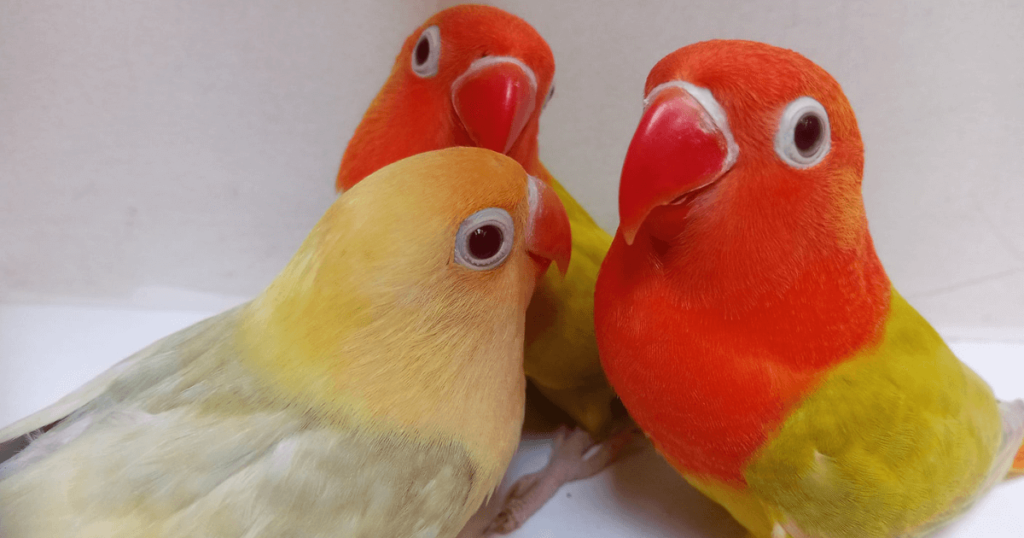Introduction
Lovebirds are small, colourful parrots popular as pets due to their friendly and affectionate nature. They are known for their strong pair bonding and social behaviour, which makes them a great addition to any family. In this article, we will cover the different species of lovebirds, their characteristics, care, health, breeding, training, and lifespan.

Table of Contents
Lovebird Species
There are nine species of lovebirds, which are classified into three genera – Agapornis, Agapornis, and Agapornis. However, the most common species that are kept as pets are:
Agapornis roseicollis
Agapornis roseicollis, also known as the peach-faced lovebird, is a small bird that is native to southwestern Africa. It is named after its pinkish-red face, which is surrounded by a green collar.
Agapornis personata
Agapornis personata, also known as the masked lovebird, is a small bird that is native to Tanzania. It is named after the black mask that covers its eyes.
Agapornis lilianae
Agapornis lilianae, also known as the Nyasa lovebird, is a small bird that is native to Malawi and Tanzania. It is named after Lillian, the wife of the collector who first identified the species.
Agapornis fischeri
Agapornis fischeri, also known as the Fischer’s lovebird, is a small bird that is native to Tanzania and northern Zambia. It is named after the German explorer Gustav Fischer.
Lovebird Characteristics
Appearance
Lovebirds are small birds that range in size from 5 to 7 inches in length. They have a stout, short-tailed body and a large, curved beak. They come in a variety of colors, with the most common being green, blue, yellow, and red.
Temperament
Lovebirds are known for their friendly and affectionate nature. They are very social birds and love to be around people. They form strong pair bonds and are often seen snuggling up to their mates.
Sociability
Lovebirds are social birds that thrive on interaction with other birds and people. They should be kept in pairs or small groups to prevent them from becoming lonely or bored.
Lovebird Care
Taking care of a lovebird requires a lot of time and effort. You need to provide them with a proper diet, a comfortable cage, and a clean environment. Lovebirds are very active birds, so it’s important to give them enough space to move around. They also need toys and perches to keep them entertained and stimulated.
Cage
The size of the cage is an important factor in keeping your lovebirds healthy and happy. The minimum size for a single lovebird is 18x18x18 inches, but it’s recommended to get a larger cage if you have more than one bird. The cage should be made of durable material, with bars that are spaced no more than 1/2 inch apart to prevent escape.
Diet
birds are omnivorous birds that eat a variety of foods, including seeds, fruits, vegetables, and insects. A balanced diet for lovebirds should consist of a high-quality seed mix, fresh fruits and vegetables, and protein sources like hard-boiled eggs or mealworms. It’s crucial to avoid feeding them avocado, chocolate, caffeine, and sugary or salty foods, as these can be toxic to birds.
Water
Lovebirds should have access to clean, fresh water at all times. Their water dish should be changed daily and cleaned regularly.
Toys and Accessories
Lovebirds are active birds that love to play and explore. They should be provided with a variety of toys and accessories, such as swings, ladders, and mirrors, to keep them entertained and mentally stimulated.
Grooming
Lovebirds should be groomed regularly to maintain their health and appearance. This includes trimming their nails, beak, and wings, and bathing them once or twice a week.
Lovebird Health
It’s important to monitor your lovebird’s health and watch for any signs of illness. Here are some common health problems that lovebirds can experience:
Common Health Problems
Lovebirds are generally healthy birds, but they can still develop health problems. Some of the most common health problems include respiratory infections, feather plucking, and beak overgrowth. Regular checkups with an avian veterinarian can help catch any health issues early on and prevent them from getting worse.
- Respiratory infections
- Psittacosis
- Feather plucking
- Beak malocclusion
- Egg binding
- Avian Pox
Signs of Illness
Signs of illness in lovebirds can include lethargy, loss of appetite, fluffed-up feathers, laboured breathing, and changes in droppings. If you notice any of these signs, it’s important to seek veterinary care right away.
- Lethargy
- Loss of appetite
- Difficulty breathing
- Sneezing
- Diarrhoea
Preventive Measures
To keep your lovebird healthy, provide them with a balanced diet, regular exercise, and plenty of socialization. It’s also important to keep their cage clean and free from bacteria and other potential health hazards.
Lovebird Breeding

If you’re interested in breeding lovebirds, there are a few things to keep in mind. Here are some key requirements for breeding lovebirds:
Breeding Requirements
- A healthy male and female lovebird
- A suitable nesting box
- A nutritious diet for the breeding pair
Breeding lovebirds require a lot of care and attention. Before you begin the breeding process, it is important to ensure that the pair is healthy and free from any diseases. A good pair of lovebirds should be at least 10-12 months old and should not be related. It is recommended to have a larger cage or a breeding box for the pair to mate and lay eggs.
Mating Behavior
The mating behaviour of lovebirds is quite interesting. The male bird will usually court the female bird by bringing her food to impress her. Once the female accepts the male, they will start to mate. The mating process can take anywhere from a few seconds to a few minutes.
Nesting and Incubation
After mating, the female lovebird will lay her eggs in a nest box. The nest box should be large enough to accommodate both the male and female birds. The female lovebird will lay anywhere from 4-6 eggs, and she will incubate them for around 23 days. During this period, the male lovebird will help in feeding the female and the chicks.
Lovebird Training
Training your lovebird can be a fun and rewarding experience for both you and your bird. Lovebirds are intelligent and sociable birds, and they can be trained to perform a variety of tricks and behaviours.
The key to successful lovebird training is patience and consistency. Start with simple commands, such as step-up and step-down, and gradually work your way up to more complex behaviours, such as flying to a target or retrieving an object.
Always use positive reinforcement techniques, such as treats or praise, to reward your bird for good behaviour. Avoid punishment or negative reinforcement, as this can damage your bird’s trust and relationship with you.
Behavioural Issues
Lovebirds can sometimes develop behavioural issues such as aggression or feather plucking. These issues can be caused by stress, boredom, or lack of socialization. It is important to address these issues as soon as possible and provide the birds with appropriate toys and activities to prevent further behavioural problems.
Lovebird Lifespan
Lovebirds can live up to 10-15 years with proper care and nutrition. The lifespan of lovebirds varies depending on the species and the environment in which they live. Some lovebirds may live longer than others, depending on their genetics and the quality of care they receive.
Conclusion
In conclusion, Lovebirds are fascinating birds with unique characteristics and behaviours that make them a popular choice among pet owners. By providing them with proper care, nutrition, and attention, you can ensure that your lovebird lives a long and healthy life. If you’re considering adopting a lovebird, be sure to do your research and consult with an avian veterinarian to ensure that you’re prepared for the responsibility of caring for these beautiful birds.
